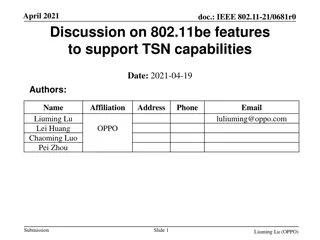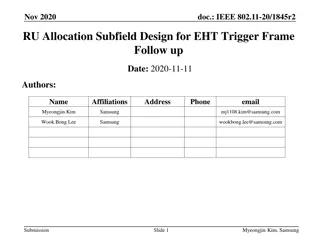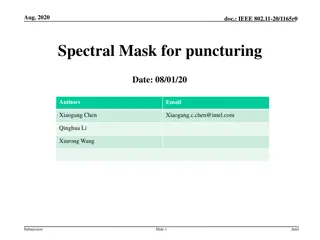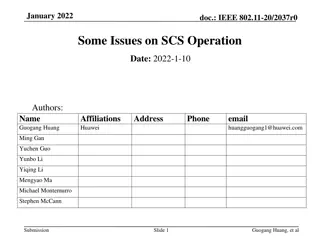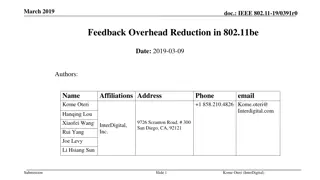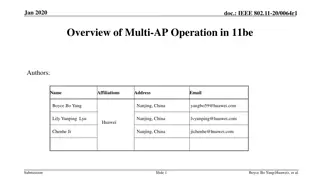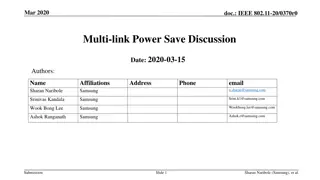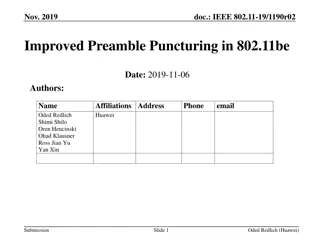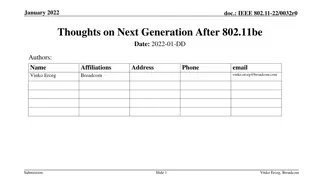Discussion on Multi-RU Allocation in IEEE 802.11be Standard
In January 2020, a discussion took place on the allocation of multiple Resource Units (RUs) to a single Station (STA) in the IEEE 802.11be standard. The proposal suggested categorizing RUs into small and large types, avoiding aggregation across multiple 20MHz channels. It emphasized assigning a single Forward Error Correction (FEC) with the same parameters to an STA allocated with multiple RUs. The structure of the Enhanced HE-SIG (EHT-SIG) was also deliberated, with considerations on MRUs that support MU-MIMO and the complexity of EHT-SIG modifications.
Uploaded on Jul 22, 2024 | 2 Views
Download Presentation

Please find below an Image/Link to download the presentation.
The content on the website is provided AS IS for your information and personal use only. It may not be sold, licensed, or shared on other websites without obtaining consent from the author. Download presentation by click this link. If you encounter any issues during the download, it is possible that the publisher has removed the file from their server.
E N D
Presentation Transcript
doc.: IEEE 802.11-20-0128-00-00be January 2020 Discussion on Multi-RU in 802.11be Date: 2020-xx-xx Authors: Name Oded Redlich Affiliations Address Huawei Phone email Shimi Shilo Genadiy Tsodik Ross Yu Jian Humengshi Discussion on Multi-RU in 802.11be Slide 1 Oded Redlich, et al (Huawei)
doc.: IEEE 802.11-20-0128-00-00be January 2020 Background It was agreed that 11be shall allow more than one Resource Unit (RU) to be assigned to a single STA. As the supported BW in 802.11be is increased to 320MHz, many multiple RUs (abbreviated here as MRU ) combinations exist In order to limit the overhead it is essential that only a subset of these combinations shall be allowed. One of the ideas discussed in various contributions ([1], [2]) is to split the RUs to 2 types: small RUs (size <=106) and large RUs (size>=242) so that MRU allocations consist of RUs of one type only. In this contribution we suggest some alternatives to define MRUs in 802.11be. Discussion on Multi-RU in 802.11be Slide 2 Oded Redlich, et al (Huawei)
doc.: IEEE 802.11-20-0128-00-00be January 2020 Assumptions for MRU A single FEC with the same parameters (MCS, coding, N_SS etc.) shall be assigned to a STA allocated with an MRU Small RUs and large RUs shall not be aggregated to the same MRU allocation Small RUs shall not be aggregated across multiple 20MHz channels As also suggested in [3], we do not limit the MRUs of small RUs to be comprised only of contiguous RUs because some schedulers allocate RUs based on SNR (e.g. CQI feedback), and these would benefit from using any combination of MRU Simulation results show that combining the best RU26 to an RU>26, to form an MRU, yields relatively low SNR gain; combining the best RU26 to a given RU26 gives a much higher SNR gain Therefore, combining RU26 with RU>26 may be defined only if the overhead is reasonable Discussion on Multi-RU in 802.11be Slide 3 Oded Redlich, et al (Huawei)
doc.: IEEE 802.11-20-0128-00-00be January 2020 Assumptions for EHT-SIG EHT-SIG (the successor of HE-SIG-B) shall have 2 fields: common field and user-specific field; both fields purposed shall be similar to 11ax The structure of EHT-SIG being comprised of a common part and a user-specific part passed motion User field length either remains 21 bits as in 11ax or is changed to a different but predefined number in order to avoid indicating it in U-SIG In 11ax, the SIG-B user-fields are decoded in a chronological order; changing this in 11be would open possibilities for MRU signaling but it would increase the complexity of the EHT-SIG MRUs comprised of RUs<106 will not support MU-MIMO Discussion on Multi-RU in 802.11be Slide 4 Oded Redlich, et al (Huawei)
doc.: IEEE 802.11-20-0128-00-00be Alternative #1 slightly modified to allow MRU signaling The first user-field content remains similar to the 11ax user-field (additional bit/bits may be added to support e.g. 16SS) The other user-fields are placed according to their locations as in 11ax, however their content is modified: January 2020 EHT-SIG user-specific field is slightly the first 11bits remain the same for STA_ID The remaining bits shall have new content related to MRU A STA shall know if an MRU is assigned to it after it decodes EHT-SIG; thus no need for special signaling for MRU user-field STA 1 STA 2 RU_Allocation Subfield = 00000100 (No change required for MRU signaling) UF1 UF2 UF3 UF4 UF5 UF6 UF7 UF8 STA1_ID New content STA2_ID 11ax user-field sub-fields STA2_ID New content STA1_ID 11ax user-field sub-fields Other STA STA1_ID New content Other STA Other STA Discussion on Multi-RU in 802.11be Slide 5 Oded Redlich, et al (Huawei)
doc.: IEEE 802.11-20-0128-00-00be Alternative #2 significantly modified to allow MRU signaling in an efficient manner January 2020 EHT-SIG shall be significantly MRUs will be signaled in a separate subfield within the user-specific field The common field Add 2 new sub-fields to the EHT-SIG common field N_MRU_1 (N x Nb bits) this field indicates how many small MRU allocation (26/52/106) exist in the corresponding 20MHz channel Nb may be either 1 or 2; we suggest to limit the number of MRUs per 20MHz to 2; more than this seems too complex and redundant N_MRU_2 (2 bits) this field indicates how many large MRU allocation (242/484/996) exist in the entire BW RU Allocation Subfield (Nx8/9 bits) N_MRU_1 (NxNb bits) N_MRU_2 (2 bits) CRC & Tail (10 bits) And in general each CC common field will be of the form: N_MRU_1 RA Subfield RA Subfield N_MRU_1 N_MRU_2 CRC & Tail Discussion on Multi-RU in 802.11be Slide 6 Oded Redlich, et al (Huawei)
doc.: IEEE 802.11-20-0128-00-00be January 2020 Alternative #2 (cont.) The user-specific field Define a new structure to the user specific field The user-specific field is split to 2 fields: Multi-RU user specific field (always precedes single-RU specific field) Single-RU user specific field (with user-fields similar to 11ax) Single-RU user specific field Multi-RU user specific field Each Multi-RU user specific field shall contain the following subfields STA_ID (11 bits) MCS (4 bits) Coding (1 bit) RU bitmap (16 bits) pointers to RUs that belong to the same MRU allocation RU bitmap: CRC & Tail (10 bits) For small RUs there are 9 26-tones RUs, therefore 7 bits are not used Alternatively, the number of RUs in each 20MHz may be extracted from the common field for large RUs there are 16 242-tones RUs (for 320MHz BW) Examples are given in the appendix Discussion on Multi-RU in 802.11be Slide 7 Oded Redlich, et al (Huawei)
doc.: IEEE 802.11-20-0128-00-00be Alternative #3 A straightforward approach may be to define new RU sizes that are comprised of combinations of 802.11ax RU sizes Add description for these RUs in the RU Allocation subfield The user-specific field will most likely be shorter (and in any case will not be longer) because only a single user-field is required for each RU/MRU (we don t need multiple user fields to describe an MRU) Based on the previous assumptions (given in slide 3) and in order to reduce the MRU signaling overhead we restrict the MRUs as follows: January 2020 add the middle RU26 to its adjacent RU52/RU106 or combine two RU26 that are different from the already defined RU52 But even with the above restrictions, there are still too many entries required to support other MRU combinations so expanding the RU Allocation table is impractical Discussion on Multi-RU in 802.11be Slide 8 Oded Redlich, et al (Huawei)
doc.: IEEE 802.11-20-0128-00-00be January 2020 Alternative #3 (cont.) So, instead of expanding the RU Allocation subfield to a huge dimension, we suggest to add another field that will follow the common field, let it be denoted as Common-MRU . This field existence should be signaled either in the common field (preferred) or in the U-SIG (similarly to signaling the SIG-B compression mode in 802.11ax) 11be Common field Common field (similar to 11ax) Common-MRU CRC+Tail MRU_1 MRU_2 MRU_3 MRU_1 MRU_2 MRU_3 Discussion on Multi-RU in 802.11be Slide 9 Oded Redlich, et al (Huawei)
doc.: IEEE 802.11-20-0128-00-00be January 2020 Alternative #3 (cont.) Small MRUs: Small MRUs: Common-MRU is encoded separately and is comprised of 3 bitmap subfields: MRU_1 9 bits: indicates which RU26 comprises the 1st MRU MRU_2 7 bits: indicates which RU26 comprises the 2nd MRU MRU_3 5 bits: indicates which RU26 comprises the 3rd MRU So, additional 21 (22 including the signaling bit) are required for signaling any combination of up to 3 MRUs per 20MHz channel Although it may appear as high overhead, we should bear in mind that a larger amount of additional bits will be saved later due to the reduction in the number of user-fields in the user-specific field Discussion on Multi-RU in 802.11be Slide 10 Oded Redlich, et al (Huawei)
doc.: IEEE 802.11-20-0128-00-00be January 2020 Alternative #3 (cont.) Large MRUs: Large MRUs: Large MRUs are identified by the corresponding RU Allocation subfield for RU>=242 tones In this case the Common-MRU field bitmap indicates which other RUs (>242) correspond to the same MRU MRU_1 8 bits (9th bit is omitted): indicate which RU242 belong to the MRU of this RU MRU_2 omitted MRU_3 omitted Similar to the small MRU case, the user-specific field overhead is also reduced Discussion on Multi-RU in 802.11be Slide 11 Oded Redlich, et al (Huawei)
doc.: IEEE 802.11-20-0128-00-00be January 2020 Alternative #3 (cont.) Example (small MRU): The RU_allocation: 0 0 0 0 0 1 1 1 Using a bitmap that is corresponding to the actual number of RUs, in this case 6 bits for MRU_1, 4 bits for MRU_2 and 2 bits for MRU_3. The unused bits are set to 0 0 0 0 0 0 1 1 1 RU52-3 RU54-4 RU52-2 Common Field: 0 0 0 0 0 1 1 1 RU26-1 Common-MRU field, MRU_1: 0 0 0 1 0 0 0 0 1 (Only 6 bits required, therefore 3 MSB are 0) Common-MRU field, MRU_2: 0 0 0 1 0 0 1 (Only 4 bits required, therefore 3 MSB are 0) Common-MRU field, MRU_3: 0 0 0 1 1 (Only 2 bits are required, therefore 3 MSB are 0) Unused bits Unused bits Unused bits The complete common field: CRC+Tail Common field (Similar to 802.11ax) + MRU signal bit MRU_1 MRU_2 MRU_3 Common_MRU Discussion on Multi-RU in 802.11be Slide 12 Oded Redlich, et al (Huawei)
doc.: IEEE 802.11-20-0128-00-00be January 2020 Alternative #3 (cont.) Decoding the user-specific field A STA will decode the user-specific field similarly to the way it does on 802.11ax. A user-field location of a MRU will be in accordance with the RU of the lowest frequency as shown in the 2 examples below Each user-field points to the first RU (the RU located in the lowest frequency) of the MRU. All STAs are already familiar with the RU structure (signaled in the common field) so they know that the user-field skips the rest of the RUs of the same MRU Discussion on Multi-RU in 802.11be Slide 13 Oded Redlich, et al (Huawei)
doc.: IEEE 802.11-20-0128-00-00be January 2020 Alternative #3 (cont.) Example (large MRU) Consider a 160MHz BW with MRUs as shown below Common Field of each 20MHz: 1 1 1 0 0 x x x (from 802.11ax, could be other options to signal the RU484) Orange Orange and green green are MRUs. Blue is a RU242 (not MRU): Only MRU_1 is valid and is 8 bits of length. MRU_2 & MRU_3 are omitted (based on the MRU signal bit + RA subfield) In the User-Specific field, each MRU will be indicated by a single reducing back the over-head single user-field, hence Discussion on Multi-RU in 802.11be Slide 14 Oded Redlich, et al (Huawei)
doc.: IEEE 802.11-20-0128-00-00be January 2020 Alternative #3 (cont.) Example (mixed MRU) Consider a 160MHz BW with MRUs as shown below Common Field of each 20MHz: 1 1 1 0 0 x x x (from 802.11ax, could be other options to signal the RU484) Orange Orange and green in slide 12 green are MRUs. Blue is a RU242 that contains small MRUs as described Discussion on Multi-RU in 802.11be Slide 15 Oded Redlich, et al (Huawei)
doc.: IEEE 802.11-20-0128-00-00be January 2020 Special Case: OFDMA with puncturing Assuming puncturing is a relatively common case (especially in dense networks): Referring to RU>484, we may use the puncturing information (likely to be defined in U-SIG) in order to define a non-contiguous large RU so that a single RU is defined instead of a MRU which is likely to require additional overhead Example: STA 1 STA 2 / Available Punctured P80 S80 STA1 allocation consists of 1st RU-242 and 2nd RU-484. Note: STA2 allocation consists of 6th RU-242 and 8th RU-242. This definition doesn t contradict other MRU definitions Both can be defined as 1 1 (punctured) RU single RU definition instead of two (MRU) (punctured) RU- -996 996, hence using a When a STA realizes that RU-996 is assigned to it, it already knows that this RU is punctured Puncturing mechanism should be revised to provide info on S80 Discussion on Multi-RU in 802.11be Slide 16 Oded Redlich, et al (Huawei)
doc.: IEEE 802.11-20-0128-00-00be Conclusions Pros January 2020 Cons Description Alternative Efficiency is not improved (Same number of user-fields as in 802.11ax) Allows to indicate additional MRU info Modify remaining bits in duplicated user-fields #1 Does not require additional entries in the RU Allocation subfield All STAs need to detect all user- specific fields MRU definition and signaling is simple MRU information may be added implementation complexity may be higher Separate MRU user-specific and Single-RU user specific fields Same error probability of SIG-B per STA #2 Single-RU STAs need to decode the MRU field in order to realize the RUs structure For MRU that consists of 3 or more RUs total size is reduced Any combination of MRU may be defined A new Common sub-field with MRU bitmap Avoid expanding the RU Allocation subfield make the implementation practical Add new content to the common field #3 Overall overhead in EHT-SIG is reduced Relevant for large Rus Special Case OFDMA with puncturing Reduce overhead Only for STAs that support puncturing Discussion on Multi-RU in 802.11be Slide 17 Oded Redlich, et al (Huawei)
doc.: IEEE 802.11-20-0128-00-00be References January 2020 [1] 11-19-1907-00-00be-multiple-ru-combinations-for-eht (Mediatek) [2] 11-19-1908-00-00be-multi-ru-support (Broadcom) [3] 11-19-1126-01-00be-enhanced-resource-unit-allocation-schemes-for- 11be (Mediatek) Discussion on Multi-RU in 802.11be Slide 18 Oded Redlich, et al (Huawei)
doc.: IEEE 802.11-20-0128-00-00be Straw Poll 1 January 2020 Do you agree that within a 20MHz channel there is no combination of 2 RUs that is statistically superior to any of the other combinations of the same size Superior in means of SNR RUs in the above refer to RUs as defined in 802.11ax For example there is no RU26+RU52 pair that is superior to the other same-size pairs Y/N/A Discussion on Multi-RU in 802.11be Slide 19 Oded Redlich, et al (Huawei)
doc.: IEEE 802.11-20-0128-00-00be Straw Poll 2 January 2020 Do you agree that within a 20MHz channel, a MRU may be comprised of non-contiguous RUs RUs in the above refer to RUs as defined in 802.11ax Y/N/A Discussion on Multi-RU in 802.11be Slide 20 Oded Redlich, et al (Huawei)
doc.: IEEE 802.11-20-0128-00-00be Straw Poll 3 January 2020 Do you agree to limit the number of small RUs exist in a multiple RU within a 20MHz channel RUs in the above refer to RUs as defined in 802.11ax Y (2 RUs) Y (3 RUs) N (4 RUs) A Discussion on Multi-RU in 802.11be Slide 21 Oded Redlich, et al (Huawei)
doc.: IEEE 802.11-20-0128-00-00be January 2020 Appendix 1: Examples Discussion on Multi-RU in 802.11be Slide 22 Oded Redlich, et al (Huawei)
doc.: IEEE 802.11-20-0128-00-00be January 2020 Nov. 2019 Alternative #2 Example (cont.) For small-RUs: a 9-bits bitmap shall indicate which 26-tones RUs in the same 20MHz channel are part of the MRU allocation. A 52-tones RU or 106 tones RU shall be indicated by the appropriate 2/4 bits. The 10th bit is reserved. RU_Allocation Subfield = 00000100 (8 user-fields) STA 1 STA 2 RU26-7 RU52-2 RU26-9 RU26-1 UF1 UF2 UF3 UF4 UF5 UF6 UF7 UF8 STA1_ID bitmap= 101101000 OR: STA1_ID N_RU=10 STA1_ID 11ax user-field sub-fields Other STA STA1_ID bitmap= 101101000 OR: STA1_ID N_RU=10 STA2_ID 11ax user-field sub-fields STA2_ID bitmap= 000000101 OR: STA2_ID N_RU=01 Other STA Other STA Discussion on Multi-RU in 802.11be Slide 23 Oded Redlich, et al (Huawei)
doc.: IEEE 802.11-20-0128-00-00be January 2020 Nov. 2019 Alternative #2 - Example (cont.) For large-RUs: a 8-bits bitmap shall indicate which 242-tones RUs in the same 80MHz channel and the next 80MHz channel are part of the MRU allocation. A 484-tones RU or 996-tones RU shall be indicated by 2/4 bits (2/4 X 242 tones-RU). The 9th and 10th bits are reserved. MRU is limited to 160MHz boundaries. CC1 CC2 CC1 CC2 CC1 CC1 CC2 CC2 STA 1 STA 2 P80 S80 CC1-common = 11000000 11001000 11000000 11000000 CC2-common = 11000000 11001000 11000000 11000000 CC1 user-specific field UF1 UF2 UF3 UF4 STA1_ID 11ax user-field sub-fields STA1_ID bitmap= 10110000 Other STA Other STA CC2 user-specific field UF1 UF2 UF3 UF4 Other STA STA1_ID bitmap= 10111000 STA2_ID 11ax user-field sub-fields STA2_ID bitmap= 0101xxxx Discussion on Multi-RU in 802.11be Slide 24 Oded Redlich, et al (Huawei)
doc.: IEEE 802.11-20-0128-00-00be January 2020 Nov. 2019 Alternative #3 - Example Example for 40MHz BW with MRU of small RU): RU Allocation Subfield (Nx8/9 bits) N_MRU_1 (Nx2 bits) N_MRU_2 (2 bits) CRC & Tail (10 bits) STA 1 STA 2 STA 3 STA 4 RU_Allocation_dubfield N_MRU_2 N_MRU_1 1 0 0 0 CC1 CRC & Tail (10 bits) 0 0 0 0 0 1 0 0 STA 5 CC2 1 0 0 0 CRC & Tail (10 bits) 0 0 0 0 1 0 1 1 Discussion on Multi-RU in 802.11be Slide 25 Oded Redlich, et al (Huawei)
doc.: IEEE 802.11-20-0128-00-00be January 2020 Alternative #3 Example (cont.) STA 1 STA 2 STA 3 STA 4 STA 5 CC1: Single-RU user specific field Multi-RU user specific field UF(RU26-5) UF(RU26-8) UF(RU26-2) STA1_ID MCS Coding MCS Coding 00000101 101101000 STA1_ID Single-RU user specific field Multi-RU user specific field CC2: MCS Coding Coding 000111100 111000000 STA3_ID UF(STA-5) STA4_ID MCS Discussion on Multi-RU in 802.11be Slide 26 Oded Redlich, et al (Huawei)
doc.: IEEE 802.11-20-0128-00-00be January 2020 Alternative #3 Example (cont.) STA 1 STA 2 RU Allocation subfield: 00000100 (8 RUs) RU Allocation subfield: 00001011 (6 RUs) STA 3 STA 4 STA 5 CC1: Single-RU user specific field Multi-RU user specific field UF(RU26-5) UF(RU26-8) UF(RU26-2) STA1_ID MCS Coding MCS Coding 00000101 10101000 STA1_ID Single-RU user specific field Multi-RU user specific field CC2: Coding 001110 MCS Coding 110000 STA3_ID UF(STA-5) STA4_ID MCS Discussion on Multi-RU in 802.11be Slide 27 Oded Redlich, et al (Huawei)
doc.: IEEE 802.11-20-0128-00-00be January 2020 Alternative #3 (cont.) 1 0 0 0 0 0 1 1 1 1 0 0 0 0 0 0 1 1 0 1 0 0 0 1 1 0 0 1 1 1 Alternative signaling The RU_allocation: RU52-3 RU54-4 RU52-2 RU26-1 The equivalent allocation using only RU26 (for the bitmap) RU26-9 RU52-2 RU26-1 RU26-7 Common Field: 0 0 0 0 0 1 1 1 Common-MRU field, MRU_1: 1 0 0 0 0 0 0 1 1 Common-MRU field, MRU_2: 0 1 0 0 0 1 1 Only 6 bits required, therefore MSB is 0) Common-MRU field, MRU_3: 0 0 1 1 1 (Only 3 bits are required, therefore 2 MSB are 0) The complete common field: RU_allocation MRU_1 MRU_2 MRU_3 Discussion on Multi-RU in 802.11be Slide 28 Oded Redlich, et al (Huawei)
doc.: IEEE 802.11-20-0128-00-00be January 2020 Assisting Slides Discussion on Multi-RU in 802.11be Slide 29 Oded Redlich, et al (Huawei)




